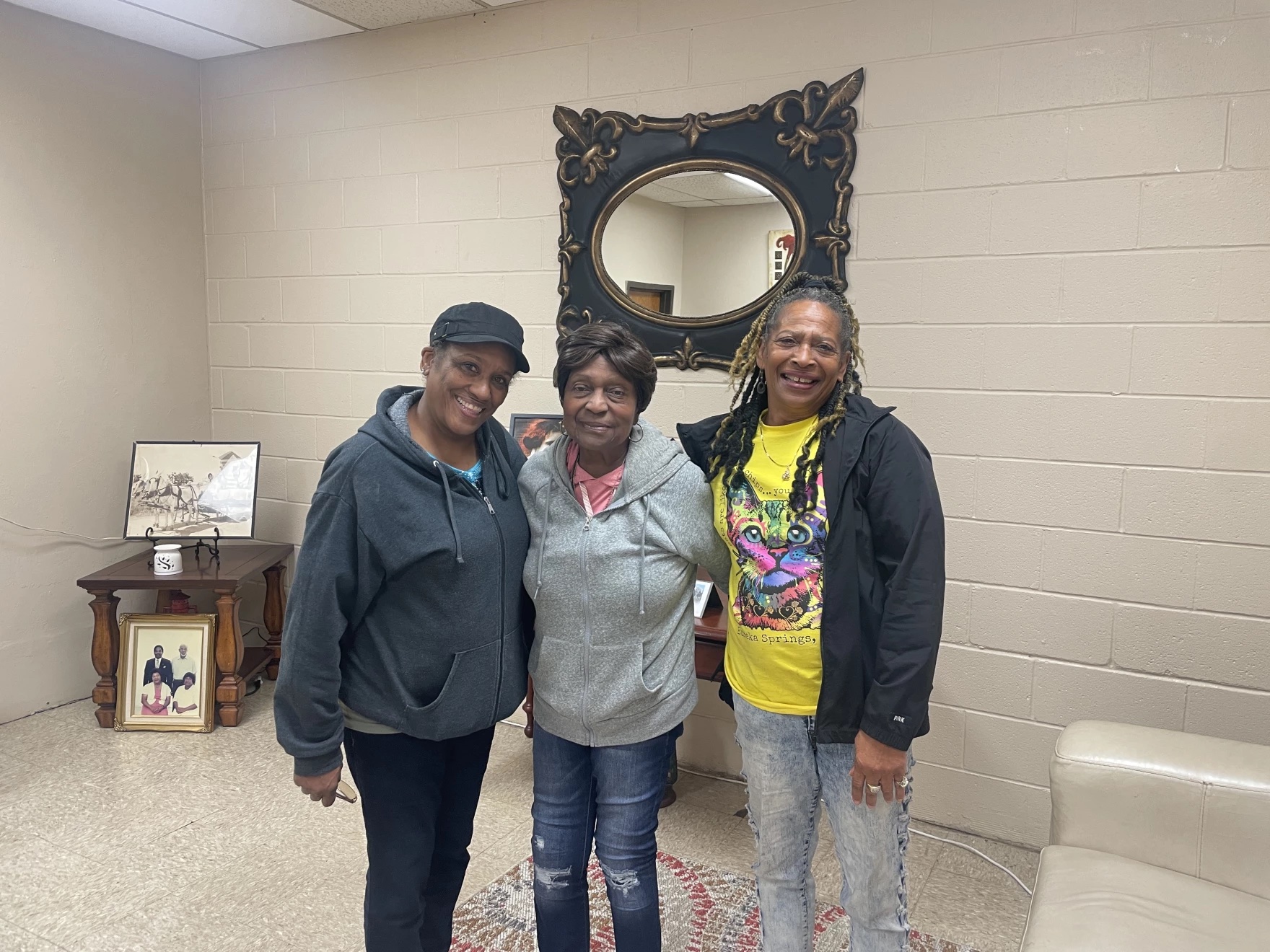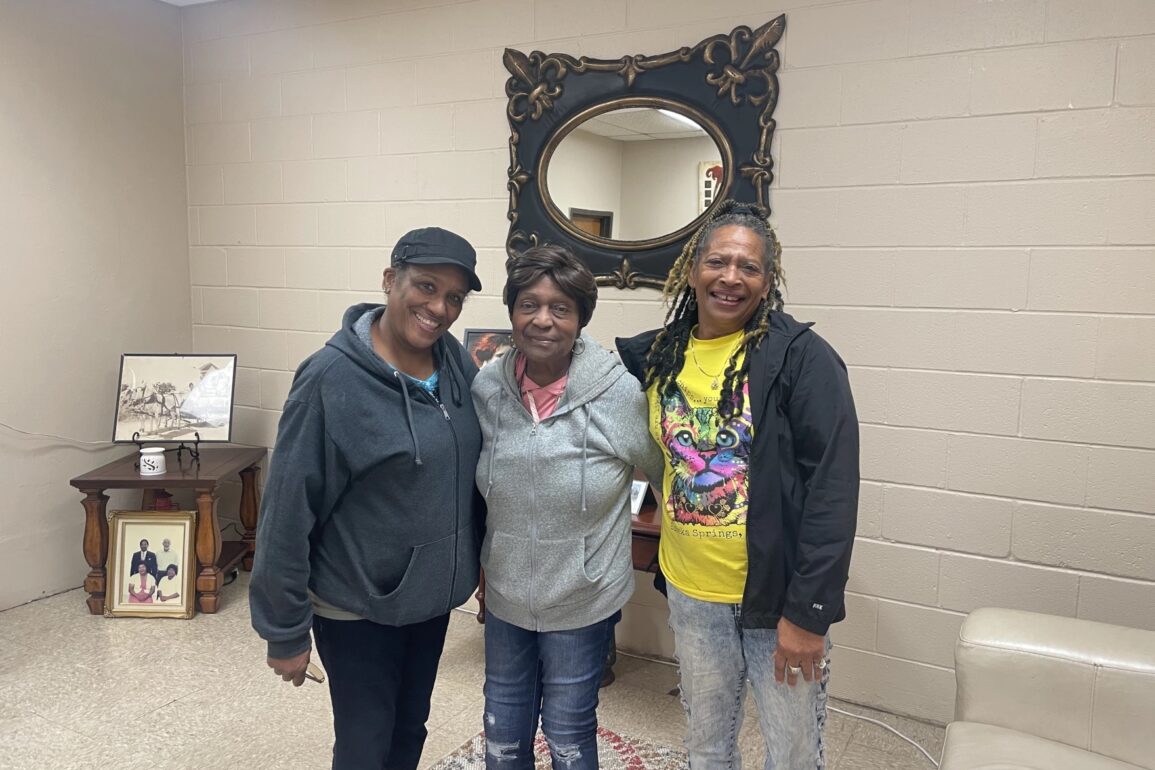TATUMS — Oklahoma State Highway 7 runs by the Mary T. Tatums Municipal Building in one of Oklahoma’s historic All-Black towns, Tatums.
Bonnie Hooks sits with her neighbors at one of the round tables inside the building. Like her grandmother, Hooks is a farmer in Tatums, where she raises pigs.
“I have grand babies,” Hooks said. “When they come, they like to pick the pigs up and bottle-feed them.”
Between 1865 and 1920, Black people founded and governed over 50 All-Black towns in the state. Only 13 remain today. Hooks and others at the table grew up helping with their family’s farm.
“I’m just a straight-up country girl, and I love the country and the hogs,” Hooks said.
Hooks said she could see her parents deal with stress, but it was never their main focus.
“I would just say even though, you know, the struggles that they went through and now have passed on down to us— it’s a mental state, but at the same time you don’t block it out,” Hooks said. “It’s reality, it’s in front of you.”
Farming is a demanding job saddled with stressors like increasingly unpredictable weather, rising input costs and changing commodity prices. On top of those issues, producers of color deal with the impacts of racism, which is linked to mental health conditions like depression and PTSD.
For years, mental health issues have been rising among people living on America’s farms and rural spaces. In Oklahoma, agriculture is a major sector of the economy. There were more than 70,300 farms in 2022, according to the latest Census of Agriculture from the U.S. Department of Agriculture.
Suicide rates are climbing faster in rural areas. They grew 46% in rural areas compared to about 27% in metro areas from 2000-2020, according to the Centers for Disease Control and Prevention. Farmers and ranchers also have higher rates of depression and face barriers to accessing mental health care services, such as traveling longer distances to receive care, affording the costs of services and a shortage of behavioral health providers.
Although Black people often have higher rates of psychological distress than their white counterparts, they are less likely to receive care and get poorer quality of care. In 2018, Black people were also 1.5 times more likely to be uninsured than white people.
Discrimination and racism are connected to bad mental and physical health outcomes.
Williard Tillman, Oklahoma Black Historical Research Project Executive Director, said in his experience, many farmers and producers worry about taking care of their families, but figuring out the best way can be a challenge.
“Because if you’ve been given something that’s been passed down from generation to generation to generation, and you have the breaking point of actually losing everything that was given to you,” Tillman said. “That’s where we are, but very seldom do you ever hear about this and our ability to be able to help in the situation til it’s in the fourth quarter and you only got two minutes or something left in the game.”
The number of Black farms has dwindled

For decades, the number of Black producers and the amount of land they own has been sharply declining. One study found Black farmers lost about $326 billion in land wealth and income from 1920-1997.
Historic discriminatory practices by the U.S. Department of Agriculture are a factor leading to the loss.
Today, socially disadvantaged producers, especially Black farmers, operate with a higher level of risk and get less government payments, according to a USDA survey.From 2018 to 2020, Black-owned farms were less than a third of the size of operations owned by farmers of other races.
According to the latest USDA Census of Agriculture, Black and African American producers declined 8.1% compared to less than one percent of white producers.
“We’re OK, personally, but as a town we struggle,” said Celano Jones of Tatums, where he has lived since 1968 and works as a producer. “We struggle because of the way the government’s set up. You know, every Black town struggle, actually because they want to make our Black town ghost towns.”
Recently, the USDA has worked to fix discriminatory practices and distributed payments through the Discrimination Financial Assistance Program, a source of financial assistance for U.S. farmers who experienced discrimination prior to 2021.
Tillman said financial issues and being denied participation in USDA programs are “the most stressful thing I see as I go across the board in dealing with ranches and some rural communities.”
What is farm stress?
Tillman worked with farm stress advocate and suicide intervention counselor Mona Lee Brock — who gained a reputation for helping farmers during the Farm Crisis of the 1980s. During this time, factors like plunging commodity prices and production costs soared, leading to farm foreclosures. Farmer suicide rates also began to rise.
He still uses her advice.
“Take every conversation as seriously as you possibly can because you never know what’s behind the door,” Tillman said.
Tillman now works with farmers in different capacities. His organization, the Oklahoma Black Historical Research Project, helps socially disadvantaged producers and rural communities get the resources they need to be successful, such as providing training and technical assistance for USDA programs.
“Just getting to them with information that we can share with them,” Tillman said. “You know, can take a lot of stress off by them being able to have a whole farm plan and go into the office and get the necessary resources they need to have a good operating farm.”
Stigma, lack of insurance coverage and travel distance are a few barriers preventing many rural residents from seeking mental health services, according to the Rural Health Information Hub.
Brent Brewer, an Oklahoma farmer and former American Farmers and Rancher Farm Stress Counselor, has been trained to identify and respond to signs of mental distress. He said that often farmers do not see a doctor regularly, so he educates everyday people in rural communities across Oklahoma on how to detect mental distress in themselves and others.
“A lot of people don’t want to get involved when someone is stressed,” Brewer said. “They just want to get away from them. And that’s not the case. What they need to do, you need to keep an eye on your neighbors and your friends and especially your family.”
From rising fuel and feed expenses to fertilizer costs, Brewer said farming has changed over the years, causing producers to be overworked and adding to the already existing farmer stress.
Adding on a drought or other events that can cause crop failures and lower commodity prices adds more weight for a producer. Brewer said more education surrounding mental health and rural health professionals is needed.
Organizations and entities stepped in across the country with resources like Farm Aid’s Farmer Hotline and the 988 Mental Health Lifeline, which people can call if they are experiencing a mental health crisis.
Organizations offer mental health resources
Across the nation, there is a need for more mental health professionals and, specifically, a need for a diverse mental health workforce. Nationally, 13% of the population is Black, but only 4% of psychologists are Black.
Mental health experts and advocates say better outcomes result from a provider understanding a person’s situation and cultural background.
“So what I hear a lot from young people is I never really got to my depression when I went to see my therapist, because I was too busy explaining all the language that I was using,” said Dawn Brown, the director of the National Alliance on Mental Illness (NAMI)’s cross‑cultural innovation and engagement task force.
She said historically, in predominantly Black communities, there has also been a breach of trust with medical providers, and being able to relate to a provider who looks like you is meaningful.
“It’s familiar. And mental health and mental illness is so unfamiliar and can be very scary,” Brown said. “So when you see someone who can put it in language that makes sense, it matters. It matters a lot.”
NAMI has mental health outreach efforts, including Sharing Hope, a community conversation series on health and wellness for people of Black and African Ancestry.
“And relationships are built at the speed of trust,” Brown said. “And we are trying to slowly get inroads into the community so that we can improve and enhance the quality of care and make it more equitable.”
In Oklahoma, every county is in a mental health professional shortage area—and providers of color are in even shorter supply. Zack Stoycoff, executive director of Healthy Minds Policy Initiative, a nonprofit organization in the state, said that his organization is working to improve the workforce capacity issues.
He said Oklahoma is making other investments to address crises when they happen. For instance, every county has a community mental health center for insured and uninsured people.
One problem for the state is behavioral workforce development, he said. People can be educated at a college or university in the state to become mental health professionals, but the area is not necessarily able to offer postdoctoral training or internships needed to become licensed.
“So almost as a matter of course, if you are graduating with a psychology degree in Oklahoma, you must leave the state to complete your education and be licensed and certified. And that’s a problem,” Stoycoff said.
This past legislative session, his organization requested almost $37 million in funding to keep Oklahomans training and working in the state.
Community Perceptions
While working to grow the state’s behavioral workforce, Stoycoff said it’s important to intentionally recruit and retain providers of color.
“It is important that the communities being served are reflected in the workforce that we’ve got,” Stoycoff said.
Back in Tatums, Hooks and other townspeople are sharing their experiences and how they view mental health. For those sitting at the table, the town is a close-knit community and people support each other. Jones said having a visiting caseworker who makes themselves available for people in Tatums would be helpful.
He said then people can meet one-on-one, and ideally, it would be without cost because people lack insurance coverage — and finances are key.
“You know, people just learn how to deal with it because they can’t afford it,” Jones said. “I mean people sit here and can’t afford to go to the doctor — and that’s what I think about and that goes right back to politics.”
This article was originally published by KOSU. KOSU is part of the Mental Health Parity Collaborative, a group of newsrooms that are covering stories on mental health care access and inequities in the U.S. The partners on this project include The Carter Center, The Center for Public Integrity and newsrooms in select states across the country.



